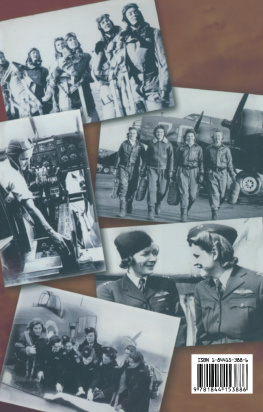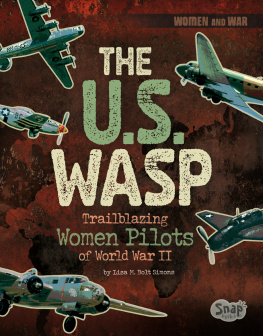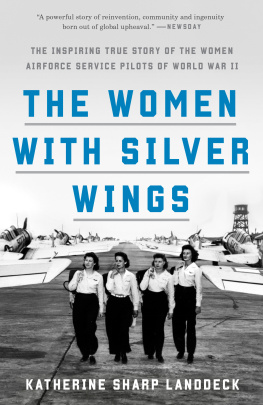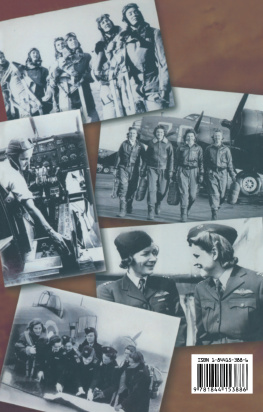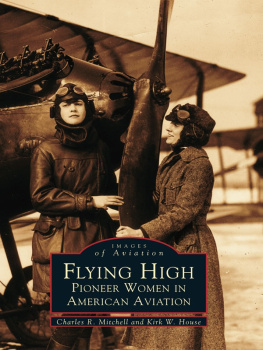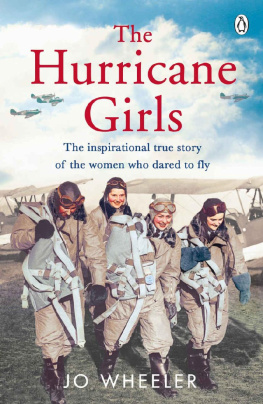SISTERS
IN
ARMS
SISTERS
IN
ARMS
Helena Schrader
Pen & Sword
AVIATION
First published in Great Britain in 2006 by
Pen & Sword Aviation
an imprint of
Pen & Sword Books Ltd
47 Church Street
Bamsley
South Yorkshire
S70 2AS
Copyright Helena Schrader, 2006
ISBN 1 84415 388 6
The right of Helena Schrader to be identified as Author of this work has
been asserted by her in accordance with the Copyright, Designs
and Patents Act 1988.
A CIP catalogue record for this book is
available from the British Library.
All rights reserved. No part of this book may be reproduced or transmitted in
any form or by any means, electronic or mechanical including photocopying,
recording or by any information storage and retrieval system, without
permission from the Publisher in writing.
Typeset in Palatino by
Phoenix Typesetting, Auldgirth, Dumfriesshire
Printed and bound in England by
Biddies Ltd, Kings Lynn
Pen & Sword Books Ltd incorporates the imprints of Pen & Sword Aviation,
Pen & Sword Maritime, Pen & Sword Military, Wharncliffe Local History,
Pen & Sword Select, Pen & Sword Military Classics and Leo Cooper.
For a complete list of Pen & Sword titles please contact
PEN & SWORD BOOKS LIMITED
47 Church Street, Barnsley, South Yorkshire, S70 2AS, England
E-mail: enquiries@pen-and-sword.co.uk
Website: www.pen-and-sword.co.uk
Contents
PART 1
Chapter One
The Wings of War
Chapter Two
Women at Arms
Chapter Three
Winning Their Wings
Chapter Four
A Womans Work
Chapter Five
The Wonderful (or Not so Wonderful) World of the Woman Pilot
Chapter Six
Broken Wings
PART 2
Chapter Seven
Handmaidens and Guinea Pigs
Chapter Eight
Friends and Foes
Chapter Nine
Separate but Not Equal
Chapter Ten
Sum of the Parts
Chapter Eleven
Age Before Beauty
Chapter Twelve
Theres a War On - Or is There?
Chapter Thirteen
Chasing the Chimera
Chapter Fourteen
Captains and Commanders
D uring the Second World War, a few carefully selected women in the United States and the United Kingdom were briefly given the unprecedented opportunity to fly military aircraft. It was not until more than thirty years later after radical social changes with regard to womens rights and roles that women were again given the chance to fly the most challenging and innovative aircraft of their age. The story of these pioneer women pilots is made even more intriguing by the fact that, despite many notable similarities in the utilisation and organisation of the women in their respective countries, they experienced radically different fates.
In both the United States and the United Kingdom, the women pilots were organised in auxiliary, civilian organisations, the WASP (Women Airforce Service Pilots) in the United States and the ATA (Air Transport Auxiliary) in Britain. Initially, only very highly qualified and experienced women pilots were accepted into the respective programmes, but eventually training programmes were established in both countries to train women with limited or no previous flying experience. The women pilots often had to overcome scepticism about their capabilities, and sometimes faced outright hostility. Yet in both countries women pilots rapidly proved that they were capable of performing the tasks assigned to them. In fact, women on both sides of the Atlantic proved that in some ways and at some tasks they were more capable than their male colleagues.
During nearly six years of service, the women of the AT A steadily won nearly all the privileges and status enjoyed by their male colleagues. Women in the ATA could and did have command authority over men. Most exceptionally, the women of the ATA were, in 1943, awarded equal pay for equal work. The American women pilots, in contrast, were expressly denied the same status, rank, privileges, pay, and benefits as their male colleagues. They were not even entitled to disability, pension or death benefits so that WASP killed in crashes along with USAAF men were the only members of the flight crew not entitled to military honours and their families received no compensation for the return and interment of the remains.
Throughout the war, the contribution of the women of the ATA to the war effort was recognised and praised both from official quarters and in the press. By contrast, theW ASP were first glamorised and made into Hollywood stars and then subjected to a slander campaign, which both denigrated their accomplishments and insulted their competence and motives. At the end of the war, the women of the ATA were honourably discharged with the same dignity and recognition as their male colleagues. The WASP, in contrast, were sent home in haste and secrecy before either the war or the job for which they had trained at great expense was done.
What accounts for this dramatic difference in the treatment of women pilots doing essentially the same job in the same war in two nations with the same cultural heritage and military objectives? Why did the WASP arouse such violent opposition at a time when the women in the ATA were harvesting praise and royal recognition?
This book seeks to answer these questions. Part 1 provides a description of the historical context, the organisational objectives and development, recruitment, training, terms of service, daily life and the deactivation of the respective organisations. The second part attempts to analyse the impact of differing military traditions, male and public attitudes, organisational composition and ethos, press relations and key personalities on the fate of the respective organisations. To the extent possible, the women who participated in the AT A and WASP have been allowed to speak for themselves. From memoirs, diaries, interviews and other secondary sources, their experiences and opinions are drawn and quoted. In addition, a number of survivors were contacted and more than a dozen kindly responded.
The story these women have to tell is exciting and intriguing. The love of flying and desire to contribute to the war effort are a common theme, binding the women across the Atlantic. But the differences are telling too. Indeed, the entire study casts light on some still very relevant differences between two nations that have repeatedly found themselves fighting side-by-side on diverse battlefields across the globe.
A BRIEF HISTORY OF THE WOMEN PILOTS OF THE ATA, WAFS, WFTD AND WASP
The Second World War did not explode unexpectedly upon an unsuspecting world. Rather, it arrived with the slow, clanking certainty of an advancing panzer. Practically from the time Hitler came to power until the German invasion of Poland, the world moved inexorably toward conflict. Yet, while the world marched consciously toward conflagration, it did so at least in the West with reluctance and foreboding. The Western Powers the United Kingdom, France and the United States resisted war to the last possible moment consistent with their role in the world and their national character.
The First World War had been won by the Western Powers at such immeasurable cost in both blood and money that it created in its wake a profound and widespread abhorrence of war. Even as Germany started down a path of militant Revisionism, breaking one after another of the bonds imposed upon it by the Treaty of Versailles, Anglo-American public opinion remained firmly pacifist or isolationist respectively. In Britain, the policy of Appeasement was not only popular, it was arguably the only policy that a democratically elected government could pursue given the mood among voters. In the United States the mood was isolationist rather than pacifist; after the US Senate refused to ratify the League of Nations Treaty and President Wilson had departed from the political stage, the American public took little interest in what was happening in the rest of the world. With widespread industrial violence, Prohibition and soon the Great Depression, there was enough to entertain and frighten them at home without taking on the added burden of Europes domestic squabbles.

